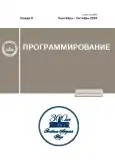Complementarity in Finite Quantum Mechanics and Computer-Aided Computations of Complementary Observables
- 作者: Kornyak V.V.1
-
隶属关系:
- Joint Institute for Nuclear Research
- 期: 编号 5 (2023)
- 页面: 59-69
- 栏目: COMPUTER ALGEBRA
- URL: https://journals.rcsi.science/0132-3474/article/view/141784
- DOI: https://doi.org/10.31857/S0132347423020115
- EDN: https://elibrary.ru/MFYKPU
- ID: 141784
如何引用文章
全文:
详细
Mathematical formulation of Bohr’s complementarity principle leads to the concepts of mutually unbiased bases in Hilbert spaces and complementary quantum observables. In this paper, we consider algebraic structures associated with these concepts and their applications to constructive quantum mechanics. We also briefly discuss some computer-algebraic approaches to the problems under consideration and propose an algorithm for solving one of them.
作者简介
V. Kornyak
Joint Institute for Nuclear Research
编辑信件的主要联系方式.
Email: vkornyak@gmail.com
Russia, 141980, Moscow oblast, Dubna
参考
- Pattee H.H. The complementarity principle in biological and social structures // Journal of Social and Biological Structures. 1978. V. 1. № 2. P. 191–200. Access mode: https://www.sciencedirect.com/science/article/pii/S0140175078800074.
- Schwinger Julian. Unitary Operator Bases // Proc Natl Acad Sci U S A. 1960. Apr. V. 46. № 4. P. 570–579. Access mode: https://www.pnas.org/doi/abs/10.1073/pnas.46.4.570.
- Wootters William K., Fields Brian D. Optimal state-determination by mutually unbiased measurements // Annals of Physics. 1989. May. V. 191. № 2. P. 363–381.
- Kornyak Vladimir V. Quantum models based on finite groups // Journal of Physics: Conference Series. 2018. Feb. V. 965. P. 012023. Access mode: https://doi.org/10.1088/1742-6596/965/1/012023
- Kornyak Vladimir V. Modeling Quantum Behavior in the Framework of Permutation Groups // EPJ Web of Conferences. 2018. V. 173. P. 01007. Access mode: https://doi.org/10.1051/epjconf/201817301007
- Kornyak Vladimir V. Mathematical Modeling of Finite Quantum Systems // Lect. Notes Comput. Sci. 2012. V. 7125. P. 79–93. 1107.5675.
- ’t Hooft Gerard. The Cellular Automaton Interpretation of Quantum Mechanics. Fundamental Theories of Physics. Cham: Springer International Publishing, 2016. ISBN: 978-3-319-82314-0. Access mode: https://doi.org/10.1007/978-3-319-41285-6.
- Вейль Герман. Теория групп и квантовая механика. Москва: “Наука”, 1986. С. 496.
- On Mutually Unbiased Bases / Durt Thomas, Englert Berthold-Georg, Bengtsson Ingemar, and Z˙ yczkowski Karol // International journal of quantum information. 2010. V. 8. № 4. P. 535–640.
- D’Ariano G. Mauro, Paris Matteo G.A., Sacchi Massimiliano F. Quantum tomography // Advances in Imaging and Electron Physics. 2003. V. 128. P. 206–309.
- Ivanovic I.D. Geometrical description of quantal state determination // Journal of Physics A: Mathematical and General. 1981. dec. V. 14. № 12. P. 3241–3245. Access mode: https://doi.org/10.1088/0305-4470/14/12/019
- Englert Berthold-Georg, Aharonov Yakir. The mean king’s problem: prime degrees of freedom // Physics Letters A. 2001. V. 284. № 1. P. 1–5.
- A New Proof for the Existence of Mutually Unbiased Bases / Bandyopadhyay Somshubhro, Boykin P Oscar, Roychowdhury Vwani, and Vatan Farrokh // Algorithmica. 2002. V. 34. № 4. P. 512–528.
- Jagannathan Ramaswamy. On generalized Clifford algebras and their physical applications // The legacy of Alladi Ramakrishnan in the mathematical sciences. Springer, 2010. P. 465–489.
- Кириллов А.А. Элементы теории представлений. Москва: “Наука”, 1978. С. 343.
- Banks T. Finite Deformations of Quantum Mechanics // arXiv: High Energy Physics – Theory. 2020. Jan. P. 2001.07662.
- Kornyak Vladimir V. Quantum mereology in finite quantum mechanics // Discrete and Continuous Models and Applied Computational Science. 2021. V. 29. № 4. P. 347–360. Access mode: https://journals.rudn.ru/miph/article/view/29428.
- Kornyak Vladimir V. Subsystems of a Closed Quantum System in Finite Quantum Mechanics // Journal of Mathematical Sciences. 2022. Apr. V. 261. P. 717–729. Access mode: https://doi.org/10.1007/s10958-022-05783-2
- Kornyak Vladimir V. Decomposition of a Finite Quantum System into Subsystems: Symbolic–Numerical Approach // Programming and Computer Software. 2022. Jul. V. 48. P. 293–300. Access mode: https://doi.org/10.1134/S0361768822020062
- Brierley Stephen, Weigert Stefan, Bengtsson Ingemar. All mutually unbiased bases in dimensions two to five // Quantum Inf. Comput. 2010. V. 10. P. 803–820.
- Brierley Stephen, Weigert Stefan. Constructing mutually unbiased bases in dimension six // Phys. Rev. A. 2009. May. V. 79. P. 052316. Access mode: https://link.aps.org/doi/10.1103/PhysRevA.79.052316.
- Three numerical approaches to find mutually unbiased bases using Bell inequalities / Colomer Maria Prat, Mortimer Luke, Frérot Iréenée, Farkas Máté, and Acín Antonio // arXiv preprint arXiv:2203.09429. 2022.
- Klappenecker Andreas, Rötteler Martin. Constructions of mutually unbiased bases // International Conference on Finite Fields and Applications / Springer. 2003. P. 137–144.
- Bron Coenraad, Kerbosch Joep. Algorithm 457: finding all cliques of an undirected graph // Communications of The ACM. 1973. V. 16. P. 575–577.
- Рейнгольд Э., Нивергельт Ю., Део Н. Комбинаторные алгоритмы: теория и практика. Москва: “МИР”, 1980. С. 478.
- Tarjan Robert Endre, Trojanowski Anthony E. Finding a Maximum Independent Set // SIAM Journal on Computing. 1977. V. 6. № 3. P. 537–546. https://doi.org/10.1137/0206038
- Carraghan Randy, Pardalos Panos M. An exact algorithm for the maximum clique problem // Operations Research Letters. 1990. V. 9. № 6. P. 375–382. Access mode: https://www.sciencedirect.com/science/article/pii/016763779090057C.
- Robson John Michael. Algorithms for Maximum Independent Sets // J. Algorithms. 1986. V. 7. P. 425–440.
- Östergård Patric R.J. A fast algorithm for the maximum clique problem // Discrete Applied Mathematics. 2002. V. 120. № 1. P. 197–207. Special Issue devoted to the 6th Twente Workshop on Graphs and Combinatorial Optimization. Access mode: https://www.sciencedirect.com/science/article/pii/S0166218X01002906.
补充文件









